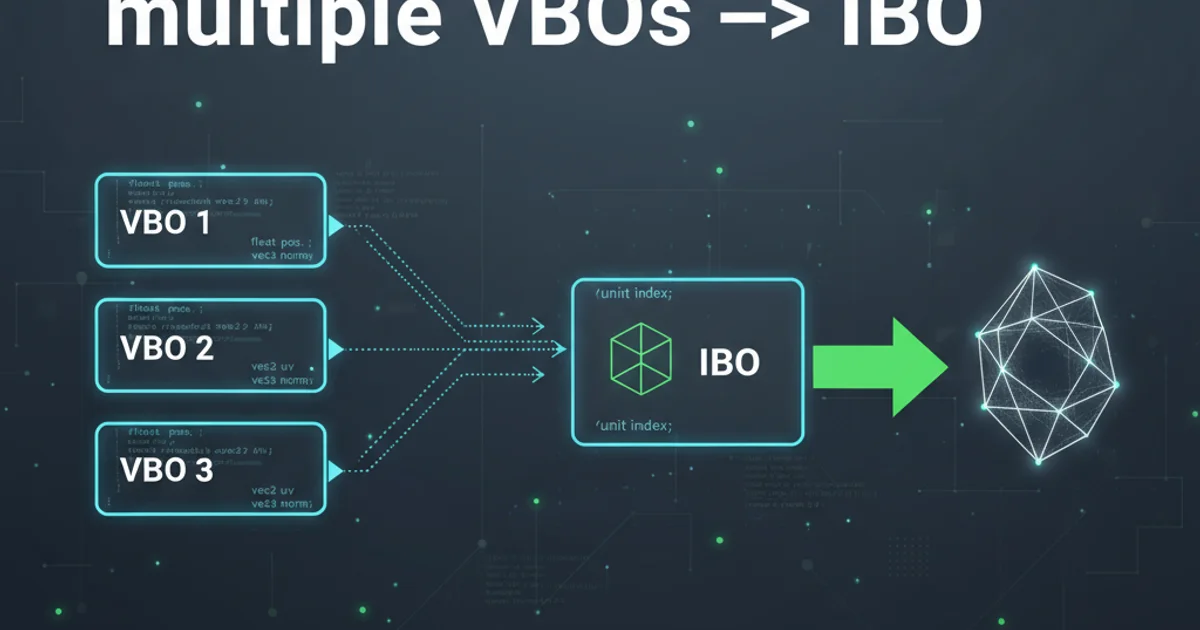multiple VBOs --> IBO
Categories:
Efficient Rendering: Combining Multiple VBOs into a Single IBO in OpenGL ES

Learn how to optimize rendering performance in OpenGL ES by consolidating multiple Vertex Buffer Objects (VBOs) into a single Indexed Buffer Object (IBO), reducing draw calls and improving efficiency.
In OpenGL ES, rendering efficiency is paramount, especially on mobile and embedded devices. A common optimization technique involves reducing the number of draw calls. When you have multiple distinct objects or meshes, each with its own Vertex Buffer Object (VBO) for vertex data, rendering them individually can lead to numerous draw calls, which introduces CPU overhead. This article explores how to combine vertex data from multiple VBOs into a single, larger VBO and use a single Indexed Buffer Object (IBO) to manage the indices for all these objects, thereby streamlining the rendering process.
Understanding VBOs and IBOs
Before diving into the consolidation process, let's briefly review VBOs and IBOs. A VBO stores vertex attributes such as position, normal, and texture coordinates in GPU memory, allowing for faster access during rendering. An IBO (also known as an Element Buffer Object or EBO) stores indices that reference vertices in a VBO. Using an IBO allows you to reuse vertices, which is particularly useful for meshes with shared vertices (e.g., a cube where each face shares vertices with adjacent faces) and can significantly reduce the amount of data transferred to the GPU.
flowchart TD
subgraph "Traditional Approach (Multiple Draw Calls)"
VBO1[VBO for Object A] --> DrawCall1(glDrawElements/Arrays)
VBO2[VBO for Object B] --> DrawCall2(glDrawElements/Arrays)
VBO3[VBO for Object C] --> DrawCall3(glDrawElements/Arrays)
end
subgraph "Optimized Approach (Single Draw Call)"
VBO_Combined[Combined VBO (Object A + B + C)]
IBO_Combined[Combined IBO (Indices for A, B, C)]
VBO_Combined --> SingleDrawCall(glDrawElements)
IBO_Combined --> SingleDrawCall
end
DrawCall1 -.-> GPU_Render[GPU Rendering]
DrawCall2 -.-> GPU_Render
DrawCall3 -.-> GPU_Render
SingleDrawCall -.-> GPU_RenderComparison of Traditional vs. Optimized Rendering with VBOs and IBOs
The Consolidation Strategy
The core idea is to append all vertex data (positions, normals, UVs) from your individual objects into one large vertex array. Simultaneously, you'll collect all index data into a single index array. However, simply concatenating indices isn't enough. Since the indices in each original IBO refer to vertices within their respective VBOs, when you combine all vertices into one large VBO, the indices for subsequent objects need to be offset. For example, if Object A has 10 vertices, the indices for Object B must be incremented by 10 to correctly point to its vertices within the combined VBO.
struct Vertex {
float position[3];
float normal[3];
float texCoord[2];
};
// Assume we have multiple objects, each with its own vertices and indices
struct MeshData {
std::vector<Vertex> vertices;
std::vector<unsigned short> indices;
};
std::vector<MeshData> meshes; // Populate this with your mesh data
// Combined data structures
std::vector<Vertex> combinedVertices;
std::vector<unsigned short> combinedIndices;
std::vector<int> drawStarts; // Stores the starting index for each object
std::vector<int> drawCounts; // Stores the number of indices for each object
unsigned int vertexOffset = 0;
for (const auto& mesh : meshes) {
// Append vertices
combinedVertices.insert(combinedVertices.end(), mesh.vertices.begin(), mesh.vertices.end());
// Append indices with offset
drawStarts.push_back(combinedIndices.size()); // Store current size as start index
for (unsigned short index : mesh.indices) {
combinedIndices.push_back(index + vertexOffset);
}
drawCounts.push_back(mesh.indices.size()); // Store count of indices for this mesh
vertexOffset += mesh.vertices.size();
}
// Now, create a single VBO and IBO from combinedVertices and combinedIndices
GLuint vbo, ibo;
glGenBuffers(1, &vbo);
glGenBuffers(1, &ibo);
glBindBuffer(GL_ARRAY_BUFFER, vbo);
glBufferData(GL_ARRAY_BUFFER, combinedVertices.size() * sizeof(Vertex), combinedVertices.data(), GL_STATIC_DRAW);
glBindBuffer(GL_ELEMENT_ARRAY_BUFFER, ibo);
glBufferData(GL_ELEMENT_ARRAY_BUFFER, combinedIndices.size() * sizeof(unsigned short), combinedIndices.data(), GL_STATIC_DRAW);
// Unbind buffers
glBindBuffer(GL_ARRAY_BUFFER, 0);
glBindBuffer(GL_ELEMENT_ARRAY_BUFFER, 0);
C++ code for combining vertex and index data from multiple meshes.
GL_UNSIGNED_INT for indices if your combined vertex count exceeds 65535, as GL_UNSIGNED_SHORT can only address up to 65536 vertices. This is crucial for larger scenes.Rendering with the Combined IBO
Once you have your single VBO and IBO, rendering all objects becomes a matter of binding these buffers once and then making multiple glDrawElements calls, each specifying an offset and count for a particular object. The drawStarts and drawCounts arrays you generated during consolidation are essential here. They tell you where in the combined IBO each object's indices begin and how many indices it uses.
// Bind the combined VBO and IBO once
glBindBuffer(GL_ARRAY_BUFFER, vbo);
glBindBuffer(GL_ELEMENT_ARRAY_BUFFER, ibo);
// Set up vertex attribute pointers (assuming a shader program is active)
glVertexAttribPointer(0, 3, GL_FLOAT, GL_FALSE, sizeof(Vertex), (void*)offsetof(Vertex, position));
glEnableVertexAttribArray(0);
glVertexAttribPointer(1, 3, GL_FLOAT, GL_FALSE, sizeof(Vertex), (void*)offsetof(Vertex, normal));
glEnableVertexAttribArray(1);
glVertexAttribPointer(2, 2, GL_FLOAT, GL_FALSE, sizeof(Vertex), (void*)offsetof(Vertex, texCoord));
glEnableVertexAttribArray(2);
// Render each object using glDrawElements with offsets
for (size_t i = 0; i < meshes.size(); ++i) {
// Apply object-specific transformations (e.g., model matrix)
// glUniformMatrix4fv(modelMatrixLoc, 1, GL_FALSE, &modelMatrices[i][0][0]);
// Draw the current object
glDrawElements(
GL_TRIANGLES,
drawCounts[i],
GL_UNSIGNED_SHORT,
(void*)(drawStarts[i] * sizeof(unsigned short)) // Offset in bytes
);
}
// Clean up
glDisableVertexAttribArray(0);
glDisableVertexAttribArray(1);
glDisableVertexAttribArray(2);
glBindBuffer(GL_ARRAY_BUFFER, 0);
glBindBuffer(GL_ELEMENT_ARRAY_BUFFER, 0);
C++ code for rendering multiple objects using a single VBO and IBO.